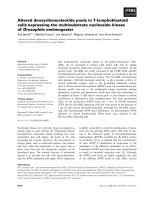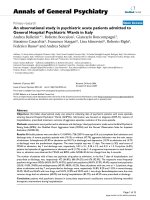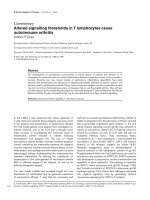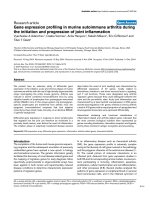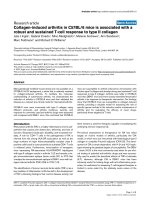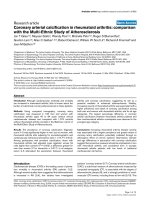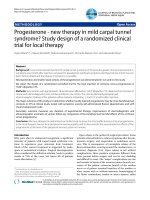Báo cáo y học: "Altered immune parameters in chronic alcoholic patients at the onset of infection and of septic shock" pot
Bạn đang xem bản rút gọn của tài liệu. Xem và tải ngay bản đầy đủ của tài liệu tại đây (386.87 KB, 10 trang )
Open Access
Available online />R312
October 2004 Vol 8 No 5
Research
Altered immune parameters in chronic alcoholic patients at the
onset of infection and of septic shock
Vera von Dossow, Corinna Schilling, Stefan Beller, Ortrud Vargas Hein, Christian von Heymann,
Wolfgang J Kox and Claudia D Spies
Department of Anesthesiology and Intensive Care Medicine, Charité – Universitätsmedizin Berlin, Berlin, Germany
Corresponding author: Claudia D Spies,
Abstract
Introduction Chronic alcoholic patients have a threefold to fourfold increased risk for developing a
severe infection or septic shock after surgery, which might be due to altered immune response. The
aim of this outcome matched study was to investigate proinflammatory and anti-inflammatory immune
parameters during the course of infection and subsequent septic shock in chronic alcoholic patients,
and to compare these parameters with those in nonalcoholic patients.
Methods Twenty-eight patients from a cohort of fifty-six with either pneumonia or peritonitis and
subsequent septic shock were selected. Fourteen patients were chronic alcoholics whereas fourteen
were nonalcoholic patients. Chronic alcoholic patients met criteria (Diagnostic and Statistical Manual
of Mental Disorders IV, of the American Psychiatric Association) for alcohol abuse or dependence.
Measurements were performed during the onset of infection (within 24 hours after the onset of
infection), in early septic shock (within 12 hours after onset of septic shock) and in late septic shock
(72 hours after the onset). Blood measurements included proinflammatory and anti-inflammatory
cytokines.
Results Chronic alcoholic patients exhibited significantly lower plasma levels of IL-8 (P < 0.010) during
the onset of infection than did matched nonalcoholic patients. In early septic shock, chronic alcoholic
patients had significantly decreased levels of IL-1β (P < 0.015), IL-6 (P < 0.016) and IL-8 (P < 0.010).
The anti-inflammatory parameters IL-10 and tumour necrosis factor receptors I and II did not differ
between alcoholic and nonalcoholic patients.
Conclusion At the onset of infection and during early septic shock, chronic alcoholic patients had
lower levels of proinflammatory immune parameters than did nonalcoholic patients. Therefore,
immunomodulatory therapy administered early may be considered in chronic alcoholic patients at the
onset of an infection because of their altered proinflammatory immune response.
Keywords: alcohol, altered immune response, cytokines, severe infection
Introduction
Chronic alcoholic patients have a twofold to fivefold increased
risk for postoperative morbidity after surgery as compared with
nonalcoholic patients [1,2]. As a result of this increased post-
operative morbidity, intensive care treatment and overall hos-
pital stay are prolonged [1,2]. Among all complications,
infections are the most serious and are associated with a
worse outcome [1-3].
Prolonged and excessive consumption of alcohol has been
shown to predispose to a variety of infectious complications,
which may be due, in part, to an inability to produce important
cytokines [4]. In experimental settings, T-cell mediated
Received: 02 February 2004
Revisions requested: 23 March 2004
Revisions received: 24 May 2004
Accepted: 15 June 2004
Published: 20 July 2004
Critical Care 2004, 8:R312-R321 (DOI 10.1186/cc2911)
This article is online at: />© 2004 Dossow et al.; licensee BioMed Central Ltd. This is an Open
Access article: verbatim copying and redistribution of this article are
permitted in all media for any purpose, provided this notice is preserved
along with the article's original URL
CAGE = Cutting down, Annoyance by criticism, Guilty feeling, and Eye-openers; CRP = C-reactive protein; IL = interleukin; TNF = tumour necrosis
factor; TNF-R = tumour necrosis factor receptor.
Critical Care October 2004 Vol 8 No 5 von Dossow et al.
R313
immunity was found to be suppressed by ethanol [4,5], which
was associated with altered cytokine production [6,7]. A sig-
nificant suppression of tumour necrosis factor (TNF)-α, as well
as of IL-6 and IL-10, in a model of chronic alcoholism was
reported [8-10]. TNF-α and IL-1β plasma cytokine levels are
induced early as the 'first hit' of infection, whereas IL-10 is the
subsequent response to this first hit, stimulated by macro-
phages and monocytes [10]. In clinical studies the delayed-
type hypersensitivity skin response was decreased in chronic
alcoholic patients before surgery and was further impaired
after surgery [2,11,12]. Immediately after surgery the IL-6/IL-
10 ratio was found to be depressed in chronic alcoholic
patients [13], and the subsequent rate of infection was ele-
vated. Several controversal clinical studies evaluated the
impact of inflammatory and mediator release on the develop-
ment of severe infection and subsequent septic shock
[14,15]. Elevated levels of IL-6 and IL-8 were associated with
higher mortality rates [14,16].
To the best of our knowledge, no other studies have been
reported that investigated the progression from infection to
septic shock in terms of immune modulating cytokines in
chronic alcoholic patients. The aim of the present study was to
investigate whether chronic alcoholic patients differed from
nonalcoholic patients with respect to plasma cytokine levels at
the onset of infection and in early septic shock.
Methods
The patients or relatives gave written, informed consent to par-
ticipate in this institutionally approved, case–control study. A
total of 14 chronic alcoholic patients with septic shock were
included, along with 14 control individuals (nonalcoholic
patients with septic shock). These 28 patients were selected
from a cohort of 56 with either pneumonia or peritonitis and
who subsequently developed septic shock. Patients with
nosocomial pneumonia met criteria given by the US Centers
for Diseases Control and Prevention [17], and nosocomial
peritonitis was diagnosed according to the Mannheimer Peri-
tonitis Index [18]. Subsequent septic shock criteria were
defined as outlined in the consensus conference of 1992 [19].
Patients were excluded if they were younger than 18 years, if
they had a diagnosis of liver cirrhosis, if consent could not be
ontained, or if they were considered 'social drinkers', with an
ethanol intake of about 20–60 g/day [1]. Basic patient charac-
teristics such as age, height, weight and Acute Physiology and
Chronic Health Evaluation III score [20] were documented.
Diagnosis of chronic alcohol abuse and alcohol
dependence
The history was recorded, and an alcoholism related question-
naire – the CAGE Questionnaire [21] – was administered to
all patients. (The acronym CAGE stands for 'Cutting down,
Annoyance by criticism, Guilty feeling, and Eye-openers'.) All
chronic alcoholic patients met criteria for alcohol abuse or
dependence (Diagnostic and Statistical Manual of Mental
Disorders IV, from the American Psychiatric Association [22]),
had a daily ethanol intake in excess of 60 g, and had a CAGE
score of 3 or more. Patients with a daily ethanol intake below
25 g and a CAGE score of 1 or less were considered to be
nonalcoholic. Conventional laboratory markers such as γ-
glutamyl transferase and mean corpuscular volume were
determined, in accordance with routine clinical practice. In
addition, a marker of higher sensitivity and specificity, namely
carbohydrate deficient transferrin, was measured.
Monitoring and management
A radial artery catheter and a central venous line were inserted
for routine cardiovascular monitoring. A fibreoptic, pulmonary
artery flotation catheter (Swan-Ganz Oximetry/TD-Catheter
model 93A-741h-7.5F; Baxter Edwards Laboratories, Irvine,
CA, USA) was inserted in all patients with sepsis. Fluids were
administered to achieve optimal left ventricular filling pressure,
reaching the plateau value for left ventricular stroke work. If the
cardiac index was less than 2.5 l/min per m
2
, then dobutamine
was administered up to 20 µg/kg per min to maintain cardiac
index between 3.0 and 3.5 l/min per m
2
. Noradrenaline (nore-
pinephrine) was administered to patients in whom mean arte-
rial pressure was below 70 mmHg. All patients were
mechanically ventilated and received continuous analgesic
sedation.
Haemodynamic measurements included heart rate and cardi-
ovascular pressures, as measured from the mid-axillary line.
Also, cardiac output measurements (as measured using the
thermodilution method with 10 ml iced physiological saline
solution as injectate, employing a cardiac computer [SAT-2
Oximeter/Cardiac Output Computer; Baxter Edwards Labora-
tories]) were taken in triplicate, with results expressed as the
mean value. Blood samples were drawn simultaneously, slowly
and continuously over 30 s.
Arterial and mixed venous blood samples were analyzed for
oxygen and carbon dioxide tensions (ABL 300; Radiometer
Inc., Copenhagen, Denmark) and for their haemoglobin con-
tent and oxygen saturation (Hemoximeter OSM 3; Radiometer
Inc.). Oxygen content, delivery and consumption were calcu-
lated according to the standard formulae.
Measurements
Measurements were performed within 24 hours after the onset
of infection (peritonitis/pneumonia), within 12 hours after the
onset of septic shock, and 72–96 hours after the onset of sep-
tic shock. With each measurement, haemodynamic and oxy-
gen transport related measures were recored and blood
samples were drawn.
Laboratory parameters
Blood samples were collected in sterile tubes and centrifuged
at 1800 g for 10 min, and serum was stored at -80°C. All
Available online />R314
mediators were analyzed at room temperature (i.e. 23°C).
Measurements were done using commercially available
enzyme-linked immunosorbent assay kits (Quantikine™ Immu-
noassay Kit; R&D Systems, Minneapolis, MN, USA) for the
cytokines (TNF-α, TNF-receptors [TNF-Rs], IL-1β, IL-6 and IL-
8). IL-10 was analyzed using a commercially available enzyme
immunoassay (TiterZyme IL-10 enzyme immunoassay kit;
Perseptive Diagnostic, Cambridge, MA, USA). Detection limits
and variation coefficients were as follows: TNF-α, 4.4 pg/ml
(5.1%); TNF-RI, 30.0 pg/ml (5.9%); TNF-RII, 10.0 pg/ml
(3.2%); IL-1β, 1.0 pg/ml (5.2%); IL-6, 0.7 pg/ml (3.6%); IL-8,
10.0 pg/ml (6.7%); and IL-10, 1.0 pg/ml (5.8%). Routine lab-
oratory markers, including leucocytes, lactate and C-reactive
protein (CRP), were also determined.
Statistical analysis
Data are presented as median (range). The Wilcoxon matched
pairs signed rank sum test was used to compare intergroup
variables. The adjusted significance (Bonferroni method) for
twice measured haemodynamic and oxygen transport param-
eters was P/2 = 0.025; the adjusted significance for the thrice
measured parameters was P/3 = 0.017.
The Friedman test was used to identify significant intragroup
differences from infection to early or late septic shock. If the
global test revealed a significant difference, then the Wilcoxon
test was used to define at which time point a significant
change occurred. P < 0.05 was considered statistically signif-
icant. Correlation coefficients were calculated according to
the Spearman rank correlation. The receiver operating charac-
teristic curve was used to provide a presentation of the rela-
tionship between sensitivity and sensitivity of mediators that
were found to be significantly different between groups, and
possibly to provide diagnostic cutoff levels. The area under the
receiver operating curve represents the probability of discrim-
ination between chronic alcoholic patients and nonalcoholic
patients [23].
Results
Basic patient characteristics did not differ significantly
between groups (Table 1). There were significant differences
with respect to alcoholism-related data and laboratory markers
(Table 1).
Immune parameters
At the onset of infection IL-8 plasma levels were significantly
lower in chronic alcoholic patients than in nonalcoholic
patients (Fig. 1), whereas no differences between groups
occurred with respect to plasma IL-1β and IL-6 levels (Figs 2
and 3). During early septic shock, IL-1β, IL-6 and IL-8 were sig-
nificantly lower in chronic alcoholic patients (Figs 1, 2, 3). IL-
1β significantly increased in nonalcoholic patients from the
onset of infection to early septic shock (Fig. 2). Also, IL-1β and
IL-6 significantly decreased in the nonalcoholic patients from
early to late septic shock (Figs 2 and 3).
Table 1
Basic patient characteristics
Characteristic Chronic alcoholic patients Nonalcoholic patients P
Age (years) 57 (24–72) 60 (23–74) 0.872
Body surface area (m
2
) 1.87 (1.57–2.40) 2.08 (1.68–2.14) 0.174
Weight (kg) 74 (50–120) 85 (55–93) 0.210
Culture positive/culture negative
(n)
4/14 3/14 >0.999
Peritonitis/pneumonia (n) 8/6 8/6 >0.999
Survivors/nonsurvivors (n) 6/8 6/8 >0.999
Nicotine abuse (n [%]) 9/14 (64%) 6/14 (43%) 0.153
APACHE III score (admission) 40 (26–76) 27 (9–74) 0.107
Length of ICU stay (days) 16 (3–50) 19 (9–41) 0.397
CAGE score 4 (3–4) 0 (0–1) <0.001
Ethanol consumption (g/day) 170 (60–380) 0 (0–20) <0.001
CDT (mg/l) 17.2 (5.1–70.1) 3.2 (2.0–8.2) <0.001
MCV (fl) 96.2 (77.2–106.0) 90.2 (78.3–102.3) 0.031
GGT (U/l) 31 (20–178) 20 (10–97) 0.074
Values are expressed as median (range), unless otherwise stated. APACHE, Acute Physiology and Chronic Health Evaluation; CAGE, alcohol-
related questionnaire; CDT, carbohydrate-deficient transferrin; GGT, γ-glutamyl transferase; ICU, intensive care unit; MCV, mean corpuscular
volume.
Critical Care October 2004 Vol 8 No 5 von Dossow et al.
R315
In the chronic alcoholic patients significant increases occurred
for soluble TNF-RI from infection to early septic shock (Table
2). However, no significant intergroup differences for soluble
TNF-RI (Table 2) were found. In addition, IL-10 plasma levels
did not differ between groups during infection to septic shock.
For the significant intergroup differences, receiver operating
curves were calculated for the progression from infection to
septic shock. The corresponding area under the curve values
were 0.60 for IL-1β, 0.62 for IL-6, and 0.66 for IL-8.
Conventional laboratory markers
CRP was significantly increased in chronic alcoholic patients
at the onset of infection as compared with non-alcoholic
patients (Table 3). During early septic shock, leucocyte count
was significantly increased in the chronic alcoholic patients
(Table 3).
Chronic alcoholic patients had a significantly lower oxygena-
tion index during early and late septic shock than did nonalco-
holic patients (Table 4). The oxygenation index in chronic
alcoholic patients with pneumonia was not statistically differ-
ent from that in chronic alcoholic patients with peritonitis.
Outcome
In the present study the period between establishing infection
and development of septic shock did not differ between
chronic alcoholic patients (5 [2–10] days) and nonalcoholic
patients (4 [1–129] days; P < 0.171). Numbers of culture-
positive versus culture-negative samples did not differ
between groups (Table 1). The identities of the positive cul-
tures isolated from blood culture or peritoneal swab/histology
were as follows: Enterococcus faecium (n = 3), Streptococ-
cus pyogenes (n = 2), Staphylococcus aureus (n = 1) and
Enterococcus faecalis (n = 1). All patients with peritonitis
were surgical patients. All infections were hospital acquired.
The survival rate for nonalcoholic patients with septic shock
was 53% (10/19), whereas only 43% (9/19) of the chronic
alcoholic patients survived. With regard to mortality rates,
47% (9/19) of the nonalcoholic patients and 57% (12/21) of
the chronic alcoholic patients died (Table 1).
Figure 1
Interleukin (IL)-8 in the course of septic shock in chronic alcoholic patients and nonalcoholic patientsInterleukin (IL)-8 in the course of septic shock in chronic alcoholic patients and nonalcoholic patients.
Available online />R316
Discussion
The most important finding was that chronic alcoholic patients
had lower plasma levels of cytokines at the onset of infection
and in early septic shock, in particular IL-1β, IL-6 and IL-8.
Proinflammatory cytokines
This is the first clinical study to demonstrate an altered plasma
cytokine response in chronic alcoholic patients at the onset of
infection and early septic shock.
Experimental studies have shown that ethanol modulates
cytokine secretion and synthesis in vivo and in vitro [24]. In
vitro, alcohol blunted the stimulation of cytokine production by
lipopolysaccharide, and the alcohol induced decrease in
cytokine synthesis was proportional to the level of alcohol con-
sumption [6]. Also, levels of production of TNF-α and IL-8 in
mast cells as well as in blood monocytes were downregulated
by clinically relevant ethanol concentrations [25,26].
In a clinical study [27], alveolar macrophages and their ability
to produce cytokines locally were studied because of the high
risk for pneumonia associated with chronic alcoholism. In vitro
stimulation of alveolar macrophages from chronic alcoholic
persons resulted in significant suppression of TNF-α as com-
pared with those from healthy control individuals. The local
pulmonary suppressive effects of acute or chronic alcoholism
have been described [8,10]. In chronic alcoholic patients, cir-
culating IL-1β, IL-6 and TNF-α levels were significantly ele-
vated as compared with nonusers of alcohol, and this elevation
was correlated with liver disease [28]. In the present study,
patients with active liver cirrhosis were excluded because of
the different cytokine kinetics that occur in the presence of
liver disease.
That levels of systemic proinflammatory cytokines were signif-
icantly lower in chronic alcoholic patients than in nonalcoholic
patients in early sepsis is an important new finding. The proin-
flammatory response to invading micro-organisms might be
fundamentally impaired in chronic alcoholism, and this may
contribute to the clinically evident immune alteration in such
patients. This is in contrast to a previous report that found that
TNF-α is elevated in early infection in patients developing sep-
tic shock [29]. The latter may be the effect of a severe infection
whereas the former may be the cause of progression of the
disease. However, this remains speculative and requires fur-
ther investigation.
Figure 2
Interleukin (IL)-1β in the course of septic shock in chronic alcoholic patients and nonalcoholic patientsInterleukin (IL)-1β in the course of septic shock in chronic alcoholic patients and nonalcoholic patients.
Critical Care October 2004 Vol 8 No 5 von Dossow et al.
R317
Anti-inflammatory cytokines
In the present study no differences with respect to IL-10 levels
were found between groups either during the initial develop-
ment of infection or in early septic shock.
In previous studies IL-10 was produced in large amounts dur-
ing septicaemia and septic shock [30]. Increased IL-10 pro-
duction by human blood monocytes was observed after acute
ethanol treatment [31]. Considering the ability of IL-10 to
inhibit monocyte function, it is likely that elevated IL-10 levels
contribute to the disturbed cellular immune response
observed after acute alcohol treatment. However, we did not
find a difference in response of chronic alcoholic patients with
respect to IL-10. The reasons for this might be, first, that
elevated IL-10 levels occur earlier in the development of infec-
tion and may not be seen later in the course of the disease
[13]. Second, the reduced proinflammatory response might
have contributed to lower IL-10 levels [14], and therefore no
difference was found between groups. In addition, no signifi-
cant intergroup differences were found with respect to soluble
TNF-RI and TNF-RII. A significant rise in soluble TNF-RI was
noted from the onset of infection to early septic shock in the
chronic alcoholic patients. High values of soluble TNF-Rs were
reported during severe sepsis [32], which was confirmed by
previous data. One study evaluated the in vitro expression of
TNF-Rs on macrophages in response to ethanol exposure
[33]; ethanol significantly reduced the expression of TNF-Rs
on interferon-γ stimulated pulmonary macrophages. In the
present study we found that levels of TNF-Rs were not sup-
pressed, and so hypothetically chronic alcoholic patients have
a preferentially anti-inflammatory immune response.
In particular, plasma levels of IL-6 were significantly lower in
chronic alcoholic patients in our study. Although IL-6 was ini-
tially found to be proinflammatory, recent findings suggest that
IL-6 has anti-inflammatory effects [34]. Therefore, IL-6 might
contribute to the resolution of acute and chronic inflammatory
processes by direct suppression of IL-1β and TNF-α [35].
Patient characteristics
In the present study CRP was significantly increased in
chronic alcoholic patients during infection. This is in accord-
ance with a previous study conducted in patients with a daily
alcohol intake of more than 80 g [36]. Chronic alcohol con-
sumption is associated with higher CRP concentrations. CRP
is mainly regulated by proinflammatory cytokines [37]. Proin-
flammatory cytokines were significantly decreased in early
septic shock and did not differ in late septic shock. Addition-
Figure 3
Interleukin (IL)-6 in the course of septic shock in chronic alcoholic patients and nonalcoholic patientsInterleukin (IL)-6 in the course of septic shock in chronic alcoholic patients and nonalcoholic patients.
Available online />R318
Table 2
Immune parameters at onset of infection, early and late septic shock
Parameter Chronic alcoholic patients Nonalcoholic patients P
IL-10 (pg/ml)
Infection 35 (2–37) 41 (12–392) 0.110
Early septic shock 37 (4–371) 66 (2–255) 0.590
Late septic shock 30 (2–118) 35 (0–81) 0.576
Soluble TNF-RI (pg/ml)
Infection 3440 (1280–6680)* 4750 (3540–7880) 0.153
Early septic shock 10,860 (2260–16,670)* 7170 (3280–14,950) 0.622
Late septic shock 9410 (1240–15,940) 7920 (4130–15,000) 0.775
Soluble TNF-RII (pg/ml)
Infection 7280 (3990–8500) 7180 (5930–8890) 0.668
Early septic shock 8070 (3500–8500) 7900 (5100–10,000) 0.895
Late septic shock 7980 (3050–8500) 8120 (5480–10,660) 0.567
TNF-α (pg/ml)
Infection 10 (4–18) 19 (12–93) 0.048
Early septic shock 14 (1–56) 14 (3–29) 0.385
Late septic shock 10 (1–29) 10 (7–16) 0.723
Values are expressed as median (range). IL, interleukin; TNF, tumour necrosis factor; TNF-R, tumour necrosis factor receptor. *Significant changes
from infection to early septic shock, and from early septic shock to late septic shock.
Table 3
Clinical and laboratory signs of infections
Sign Chronic alcoholic patients Nonalcoholic patients P
Temperature (°C)
Infection 37.2 (36.8–38.1) 37.5 (37.1–38.8) 0.851
Early septic shock 37.8 (36.2–39.8) 38.7 (37.6–39.9) 0.037
Late septic shock 38.1 (36.6–38.8) 37.2 (35.8–39.2) 0.413
Leucocytes (×10
9
/l)
Infection 8.9 (4.4–13.2) 10.2 (3.4–10.2) 0.663
Early septic shock 18.9 (6.5–45.8) 9.5 (3.5–13.9) <0.010
Late septic shock 15.0 (9.8–39.2) 17.8 (12.3–33.2) 0.717
CRP (mg/l)
Infection 110 (80–223) 54 (8–72) <0.010
Early septic shock 203 (75–266) 144 (42–323) 0.162
Late septic shock 124 (44–210) 120 (90–258) 0.690
Lactate (mmol/l)
Infection 1.6 (0.8–2.0) 1.9 (1.0–5.1) 0.174
Early septic shock 2.3 (1.4–3.2) 1.9 (1.0–5.1) 0.520
Late septic shock 2.0 (0.8–4.5) 2.0 (0.7–2.8) 0.702
Value are expressed as median (range). CRP, C-reactive protein.
Critical Care October 2004 Vol 8 No 5 von Dossow et al.
R319
ally CRP might not be stimulated adequately in chronic alco-
holic patients in early or late septic shock, which might be
explained as an immune breakdown. There was a significant
increase in leucocyte count in early septic shock. The leuco-
cyte count has low predictive ability as a marker of infection
[38]. A marked activation of the hypothalamic–pituitary–adre-
nal axis occurs during ethanol withdrawal, and this could result
in an hypercortisolism mediated leucocytosis in early septic
shock [39].
Chronic alcoholic patients had a significantly lower oxygena-
tion index, which might be due to the higher number of smok-
ers [40]. However, in the present study the percentage of
smokers was not significantly different between the groups,
and none of the patients were hypoxic because of a higher
inspired oxygen fraction, indicating that these mechanisms
were not relevant.
There were only a few significant differences in haemodynamic
parameters. Chronic ethanol abuse can be associated with a
variety of cardiovascular disorders, ranging from asympto-
matic left ventricular dysfunction to hypertension, stroke, heart
failure and sudden death from arrhythmias [2,41]. The higher
pulmonary capillary wedge pressure could be interpreted as a
result of a higher end-diastolic pressure leading to heart failure
if there were normal ventricular compliance [41].
Because the number of patients with dual addiction (i.e. to
both alcohol and nicotine) is more frequently seen than iso-
lated or no addictions, we cannot totally exclude that the
effects of ethanol on cytokine interactions were also influ-
enced by nicotine. However, in the present study no significant
difference between groups was seen. Spies and coworkers
[42] examined patients with comorbid chronic alcoholism and
nicotine abuse, and found that only TNF-α plasma levels were
significantly higher in chronic alcoholic smokers than in
chronic alcoholic nonsmokers.
Conclusion
In conclusion, chronic alcoholic patients exhibited lower levels
of proinflammatory immune parameters and of IL-6 during
infection and early sepsis, which might be due to an inhibitory
effect on proinflammatory cytokine production induced by
alcohol abuse and which might contribute to the clinically evi-
dent immune alteration. Therefore, chronic alcoholic patients
may benefit from immune monitoring and early immune modu-
latory treatment at the onset of severe infections. However,
this requires further investigation.
Competing interests
None declared.
Table 4
Haemodynamic and oxygen transport related data and catecholamines
Variables Septic shock Chronic alcoholic patients Nonalcoholic patients P
Heart rate (beats/min) Early 104 (69–143) 122 (99–140) 0.048
Late 111 (52–153) 106 (91–146) 0.696
MAP (mmHg) Early 84 (69–112) 76 (59–94) 0.060
Late 78 (68–113) 78 (61–101) 0.643
PCWP (mmHg) Early 16 (9–19) 11 (8–15) 0.021
Late 15 (8–20) 10 (8–15) 0.312
Cardiac index (l/min per
m
2
)
Early 5.1 (3.5–6.2) 5.0 (3.0–10.4) 0.940
Late 4.6 (3.4–7.00) 4.0 (3.3–4.8) 0.196
DO
2
(ml/min per m
2
) Early 721 (489–888) 718 (408–1366) 0.870
Late 693 (485–922) 580 (453–817) 0.366
VO
2
(ml/min per m
2
) Early 140 (114–237) 181 (49–330) 0.178
Late 162 (95–263) 143 (33–253) 0.437
PaO
2
/FiO
2
(mmHg) Early 198 (110–256) 282 (188–320) <0.010
Late 193 (151–298) 291 (161–511) 0.020
Noradrenaline (µg/kg per
min)
Early 0.3 (0.1–0.8) 0.5 (0.2–1.0) 0.112
Late 1.3 (0.1–1.7) 1.1(0.1–2.4) 0.522
Values are expressed as median (range). DO
2
, oxygen delivery; MAP, mean arterial pressure; PaO
2
/FiO
2
, arterial oxygen tension/fractional
inspired oxygen ratio (oxygenation index); PCWP, pulmonary capillary wedge pressure; VO
2
, oxygen consumption.
Available online />R320
Acknowledgements
The authors should like to thank Jordan Rettig, a native English speaker,
and Prof. Dr. K-D Wernecke for his statistical help (Head of the Institute
for Medical Biometrics, Humboldt-University of Berlin). This study was
supported in part by the German Research Society (DFG SP 432/1-1
and /1-2).
References
1. Spies CD, Nordmann A, Brummer G, Marks C, Conrad C, Berger
G, Runkel N, Neumann T, Muller C, Rommelspacher H, et al.:
Intensive care unit stay is prolonged in chronic alcoholic men
following tumor resection of the upper digestive tract. Acta
Anaesthesiol Scand 1996, 40:649-656.
2. Tønnesen H, Petersen KR, Højgaard L, Stokholm KH, Nielsen HJ,
Knigge U, Kehlet H: Postoperative morbidity among symptom-
free alcohol misusers. Lancet 1992, 340:334-337.
3. Fernández-Solá J, Junqué A, Estruch R, Monforte R, Torres A, Urb-
ano-Marquez A: High alcohol intake as a risk and prognostic
factor for community-acquired pneumonia. Arch Intern Med
1995, 155:1649-1654.
4. Spies C, Tønnesen H, Andreasson S, Helander A, Conigrave K:
Perioperative morbidity and mortality in chronic alcoholic
patients. Alcohol Clin Exp Res 2001:164S-170S.
5. Zisman DA, Strieter RM, Kunkel SL, Tsai WC, Wilkowski JM, Buck-
nell KA, Standiford TJ: Ethanol feeding impairs innate immunity
and alters expression of Th1- and Th2-phenotype cytokines in
murine Klebsiella pneumonia. Alcohol Clin Exp Res 1998,
22:621-627.
6. Jerrels TR: Alcohol effects on the immune system. Third Annual
Meeting of the Alcohol and Drug Abuse Immunology Sympo-
sium, Vail, Colorado, March 25–29. Alcohol 1993, 10:335-342.
7. Szabo G, Mandrekar P, Girouard L, Catalano D: Regulation of
human monocyte functions by acute ethanol treatment:
decreased tumor necrosis factor-α, interleukin1β and elevated
interleukin-10, and transforming growth factor-β production.
Alcohol Clin Exp Res 1996, 20:900-907.
8. D'Souza NB, Nelson S, Summer WR, Deaciuc IV: Alcohol modu-
lates alveolar macrophage tumor necrosis factor-α, superox-
ide anion, and nitric oxide secretion in the rat. Alcohol Clin Exp
Res 1996, 20:156-163.
9. Xie J, Kolls J, Bagby G, Greenberg SS: Independent suppres-
sion of nitric oxide and TNF alpha in the lung of conscious rats
by ethanol. FASEB J 1995, 9:253-261.
10. Wang Y, Huang DS, Giger PT, Watson RR: Influence of chronic
dietary ethanol cytokine production by murine splenocytes
and thymocytes. Alcohol Clin Exp Res 1994, 18:64-70.
11. Woiciechowsky C, Asadullah K, Nestler D, Eberhardt B, Platzer C,
Schoning B, Glockner F, Lanksch WR, Volk HD, Docke WD: Sym-
pathetic activation triggers systemic interleukin-10 release in
immunodepression induced by brain injury. Nat Med 1998,
7:808-813.
12. Tonnesen H, Kaiser AH, Nielsen BB, Pederson AE: Reversibility
of alcohol-induced immune depression. Br J Addict 1992,
87:1025-1028.
13. Sander M, Irwin M, Sinha P, Naumann E, Kox WJ, Spies CD: Sup-
pression of interleukin-6 to interleukin-10 ratio in chronic alco-
holics: association with postoperative infections. Intensive
Care Med 2002, 28:285-292.
14. Bonten MJ, Froon A, Gaillard C, Greve JW, Dentener MA, de
Leeuw PW, Drent M, Stobberingh EE, Buurman WA: The sys-
temic inflammatory response in the development of ventilator-
associated pneumonia. Am J Respir Crit Care Med 1997,
156:1105-1113.
15. Froon AH, Bonten MJ, Gaillard CA, Greve JW, Dentener MA, de
Leeuw PW, Drent M, Stobberingh EE, Buurman WA: Prediction
of clinical severity and outcome of ventilator-associated pneu-
monia. Comparision of simplified acute physiology score with
systemic inflammatory mediators. Am J Respir Crit Care Med
1998, 158:1026-1031.
16. Casey LC, Balk A, Bone RC: Plasma cytokine and endotoxin
levels correlate with survival in patients with sepsis syndrome.
Ann Intern Med 1993, 119:771-777.
17. Garner JS, Jarvis WR, Emori TG, Horan TC, Hughes JM: CDC def-
initions for nosocomial infections, 1988. Am J Infect Control
1988, 16:128-140.
18. Linder MM, Wacha H, Feldmann U, Wesch G, Streifensand RA,
Gundlach E: The Mannheim peritonitis index. An instrument for
the intraoperative prognosis of peritonitis [in German]. Chirurg
1987, 58:84-92.
19. Members of the American College of Chest Physisians/ Society of
Critical Care Medicine Consensus Conference Committee: Amer-
ican College of Chest Physisians/Society of Critical Care Med-
icine Consensus Conference (1992) definitions for sepsis and
organ failure and guidelines for the use of innovative thera-
pies in sepsis. Crit Care Med 1992, 20:864-874.
20. Knaus WA, Wagner DP, Draper EA, Zimmerman JE, Bergner M,
Bastos PG, Sirio CA, Murphy DJ, Lotring T, Damiano A, et al.: The
APACHE III Prognostic System. Chest 1991, 100:1619-1636.
21. Ewing JA: Detecting alcoholism. The CAGE Questionnaire.
JAMA 1984, 252:1905-1907.
22. American Psychiatric Association: DSM-IV Options Book Wash-
ington, DC: American Psychiatric Association; 1991.
23. Beck JR, Schultz EK: The use of the relative operating charac-
teristics (ROC) curves in test performance evaluation. Arch
Pathol Lab Med 1986, 110:13-20.
24. Ahluwalia B, Wesley B, Adeyiga O: Alcohol modulates cytokine
secretion and synthesis in human fetus: an in vivo and in vitro
study. Alcohol 2000, 21:207-213.
25. Toivari M, Maki T, Suutarla S, Eklund KK: Ethanol inhibits IGE-
induced degranulation and cytokine production in cultured
mouse and human mast cells. Life Sci 2000, 67:2795-2806.
26. Arbabi S, Garcia I, Bauer JG, Maier RV: Alcohol inhibits IL-8 and
TNF: role of the p38 pathway. J Immunol 1999, 162:7441-7445.
27. Omidvari K, Casey R, Nelson S, Olariu R, Shellito JE: Alveolar
macrophage release of tumor-necrosis-factor-α in chronic
alcoholic patients without liver disease. Alcohol Clin Exp Res
1998, 22:567-572.
28. Khoruts A, Stahnke L, McClain C, Logan G, Allen JI: Circulating
tumor necrosis factor, interleukin-1 and interleukin-6 concen-
trations in chronic alcoholic patients. Hepatology 1991,
13:267-275.
29. Brede K, Kern H, Morciniec P, Katja B, Harmut K, Pawel M, Stefan
B, Kox WJ, Spies CD: The value of immune modulating param-
eters in predicting the progression from peritonitis to septic
shock. Shock 2001, 15:95-100.
30. Marchant A, Alegre ML, Hakim A, Pierard G, Marecaux G, Fried-
man G, De Groote D, Kahn RJ, Vincent JL, Goldman M: Clinical
and biological significance of interleukin-10 plasma levels in
patients with septic shock. J Clin Immunol 1995, 15:266-273.
31. Mandrekar P, Catalano D, Girouard L, Szabo G: Human mono-
cyte IL-10 production is increased by acute ethanol treatment.
Cytokine 1996, 8:567-577.
32. Ertel W, Scholl FA, Gallati H, Bonaccio M, Schildberg FW, Trentz
O: Increased release of soluble tumor necrosis factor recep-
tors into blood during clinical sepsis. Arch Surg 1994,
129:1330-1337.
33. Bermudez LE, Wu M, Martinelli J, Young LS: Ethanol affects
release of TNF and GM-CSF and membrane expression of TNF
receptors by human macrophages. Lymphokine Cytokine Res
1991, 10:413-419.
Key messages
• At the onset of infection and during early septic shock,
chronic alcoholic patients had lower levels of proin-
flammatory immune parameters than did nonalcoholic
patients
• Immunomodulatory therapy administered early may be
considered in chronic alcoholic patients at the onset of
an infection because of their altered proinflammatory
immune response
Critical Care October 2004 Vol 8 No 5 von Dossow et al.
R321
34. Tilg H, Dinarello CA, Mier J: IL-6 and APP: anti-inflammtory and
immunosuppressive mediators. Immunol Today 1997,
18:428-432.
35. Mizuhara H, O'Neill E, Seki N, Ogawa T, Kusunoki C, Otsuka K,
Satoh S, Niwa M, Senoh H, Fujiwara H: T cell activation-associ-
ated hepatic injury: mediation by tumor necrosis factors and
protection by interleukin 6. J Exp Med 1994, 179:1529-1537.
36. Imhof A, Froehlich M, Brenner H, Boeing H, Pepys MB, Koenig W:
Effect of alcohol consumption on systemic markers of
inflammation. Lancet 2001, 357:763-767.
37. Pasceri V, Willerson JT, Yeh ET: Direct proinflammatory effect of
C-reactive protein on human endothelial cells. Circulation
2000, 102:2165-2168.
38. Oberhoffer M, Karzai W, Meier-Hellmann A, Bogel D, Fassbinder J,
Reinhart K: Sensitivity and specifity of various markers of
inflammation for the prediction of tumor necrosis factor-alpha
and interleukin-6 in patients with sepsis. Crit Care Med 1999,
27:1814-1818.
39. Adinoff B, Risher-Flowers D, De Jong J, Ravitz B, Bone GH, Nutt
DJ, Roehrich L, Martin PR, Linnoila M: Disturbances of hypotha-
lamic-pituitary-adrenal axis functioning during ethanol with-
drawal in six men. Am J Psychiatry 1991, 148:1023-1025.
40. Bobo JK: Nicotine dependence and alcoholism epidemiology
and treatment. J Psychoactive Drugs 1992, 24:123-129.
41. Spies CD, Sander M, Stangl K, Fernandez-Sola J, Preedy VR,
Rubin E, Andreasson S, Hanna EZ, Kox WJ: Effects of alcohol on
the heart. Curr Opin Crit Care 2001, 7:337-343.
42. Spies CD, von Dossow V, Eggers V, Jetschmann G, El-Hilali R,
Egert J, Fischer M, Schroder T, Hoflich C, Sinha P, et al.: Altered
cell-mediated immunity and increased postoperative infection
rate in chronic alcoholic patients. Anesthesiology 2004,
100:1088-1100.
